So the other day I wore the sleeveless Fair Isle I showed in my last blog. I may have been slightly optimistic to say it fit me fine. Its definitely a little on the short side. I got lots of compliments on it (the joys of working in a wool shop) but I kept finding myself pulling it down – It needed to be longer. So on this Friday night I’m going to go wild, go crazy and….. show you how I dress jumpers on my Jumper Board.
Rock and Roll
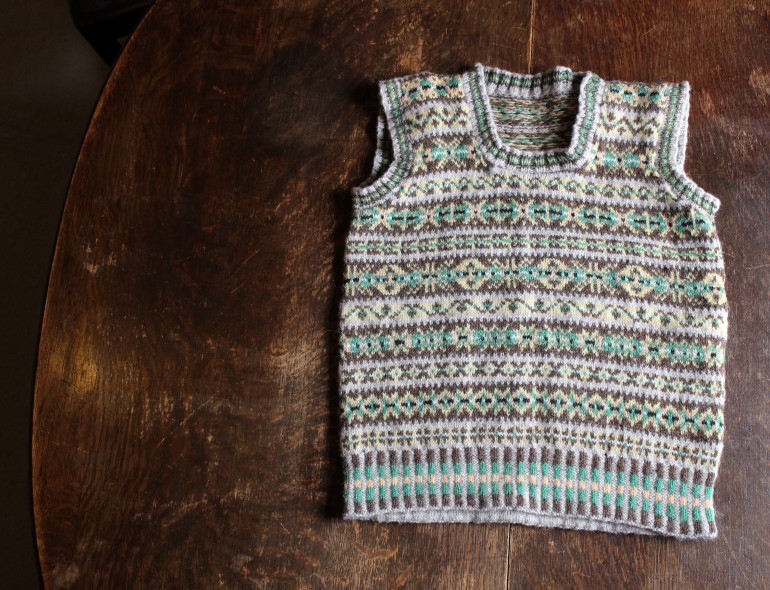
When I accidentally began collecting Shetland knitting, I started boarding my jumpers. If you want to know a bit more about jumper boards Hazel Tindall has a great blog about them. There’s also some great pictures of boards in use on the museum photo archive. So I’m not a pro at this, but I’ve boarded a few so I thought someone might like to see. (the more I write this the less realistic this seems..)
My set up is not fancy. I have a small storage tub I keep under the sink
I fill it with warm water, and add one key ingredient..
Hair conditioner! It doesn’t have to be anything fancy, but I like this stuff because it smells good and I still think its funny that I buy Horse haircare.
dunk in the gansie and smush it about for a while, I don’t think leaving it in a certain amount of time makes much difference if your just washing it. In this case and most cases, I’m not washing it because its dirty but just to reshape it so as long as it gets soaking that’s all it needs. If its something you’ve just finished knitting, I’d soak it for about half an hour to let the stitches settle.
One thing is when you take it out don’t lift it by the top or the bottom because the weight of the jumper and the water can stretch it in ways you don’t want so you lift it out together in one go and try and squeeze out as much water as you can but don’t twist it! Lay it out on a towel and roll it up.
Then stomp and squeeze as much as you want!
Its crazy how much water comes out, when you unroll it it will feel barely damp. Ive discovered the only thing more awkward than putting something on a jumper board is trying to take pictures while you do it..
As wrong as it feels to be rough with something hand knitted and wet (read vulnerable) you kinda have to be to get it on a jumper board, mines is the kind that’s hinged in the middle so you slide the jumper up a put the arms through the…arms then open it out
Then the key thing to streching it out is to pull down the knitting, you can see the board has these holes?
Well you stick in the metal pole about where you want to stretch it down to (I’m not exact in my measuring…)
make a slip knot on a piece of waste yarn and thread the other end through a needle..
slide it onto the pole and start sewing through the gansie, down and around the pole..
like so.. you can really make it stretch a lot and since the rest of the board is keeping the jumper at the right size you don’t have to worry about the gansie loosing width.
That middle bit gets a bit awkward with the wood in the way and every time I do it it comes out different but when you finish it looks like this..
Now I’ll get even more wear out of this gansie, theres something I love about boarding jumpers (i told you I was rock and roll?!) Its such a traditional thing that to me cant be bettered. I’d love to know if there is anything similar in other knitting cultures? I’ve only ever seen them in books about Shetland knitting.. sometimes with the name ‘Woolly Horse’.. who came up with that?!
I hope this has been interesting to somebody, :)
Speak soon x

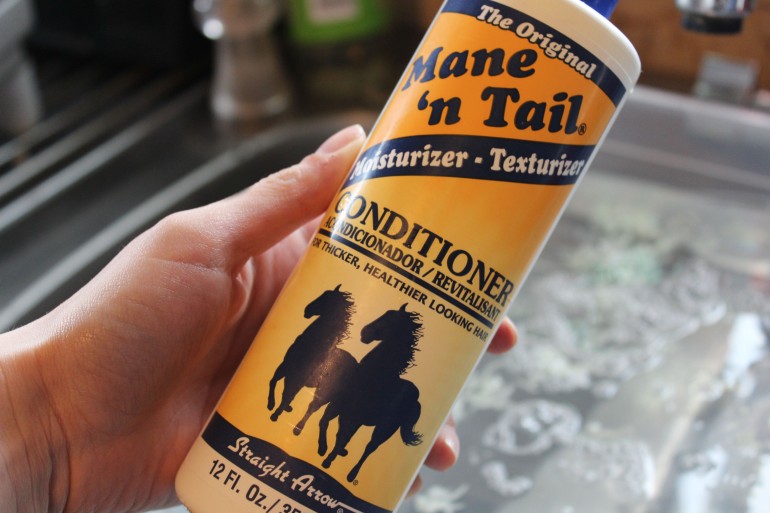
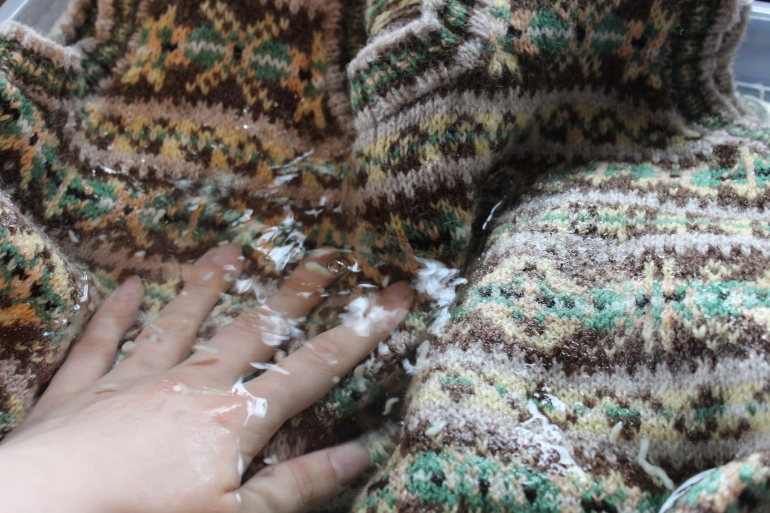
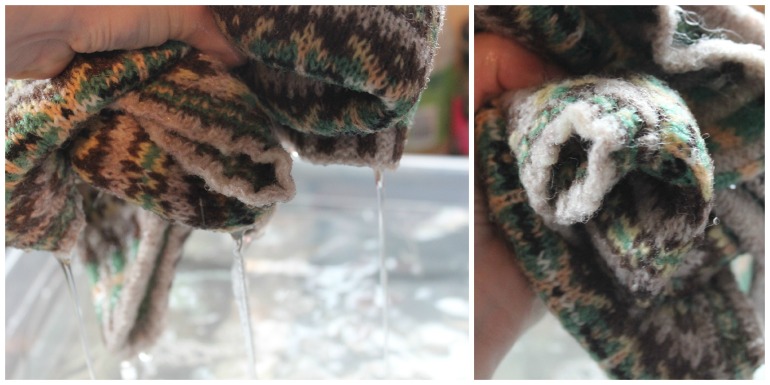
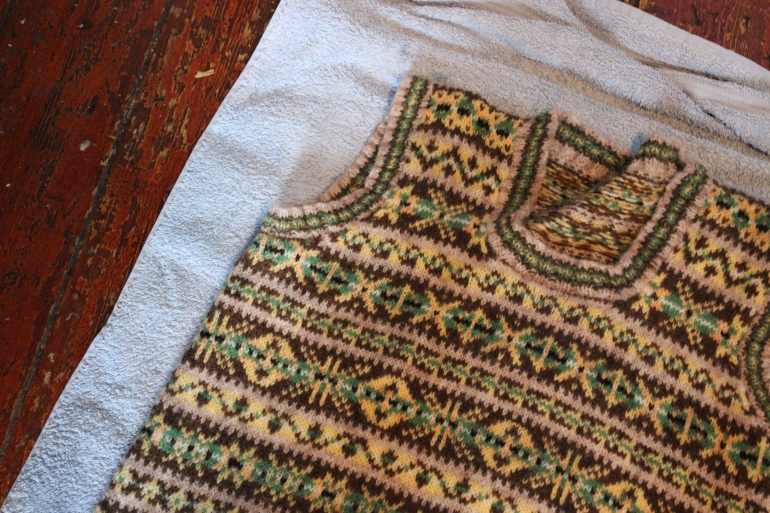
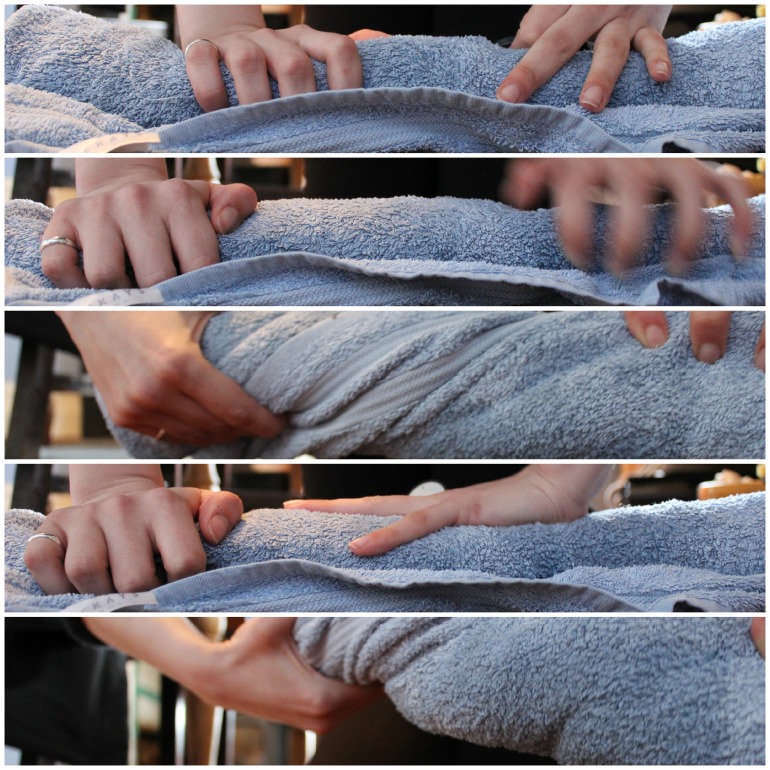
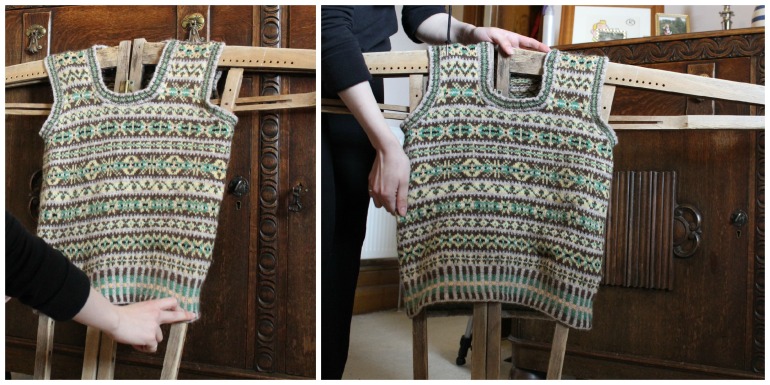
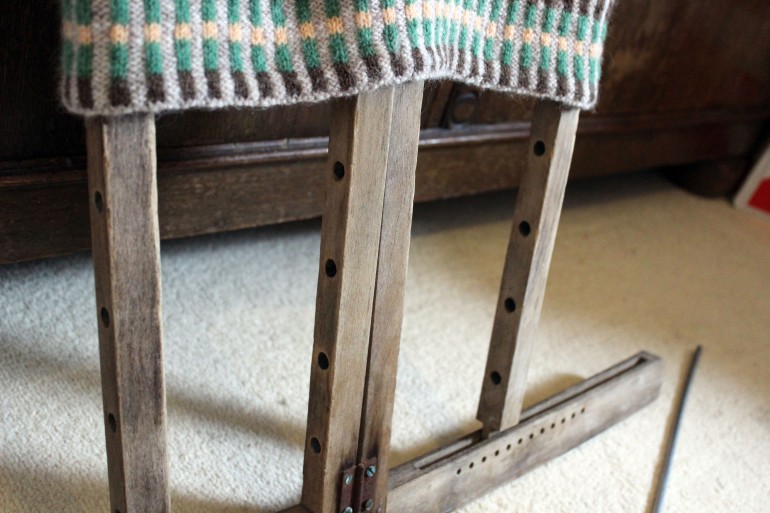
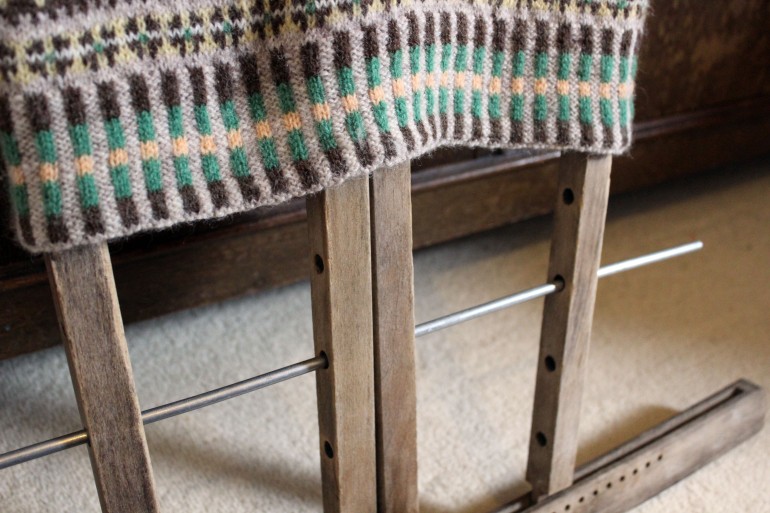

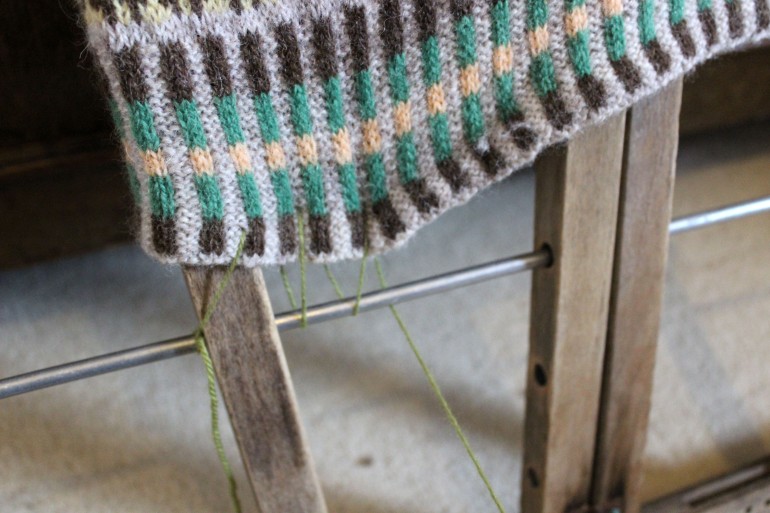
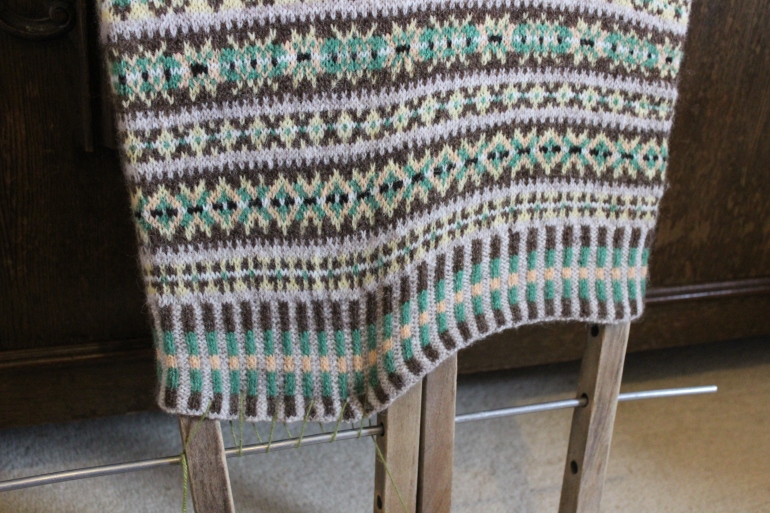


Absolutely fascinating. I had read about this process and seen items on boards in “historical” photos, but to see this as a step by step event is so meaningful. Thank you very much for sharing!
Thank you for your lovely comment! I’m so glad you liked it :)
Boarding…haha I was wondering if it was dogs or What you were ‘boarding’. I’ve had one for years and LOVE it, only have ever heard it called a ‘wooly board’. Mine hinges in the middle also and it’s sometimes like trying to dress an unruly child :) Glad you will be able to wear this more often and STOP pulling at it :)
Hahaha, yes it is exactly like an unruly child!
Genius! Thank you for your efforts to show this to us. A bit of a story, my son bought a jumper from Ireland, didn’t believe the washing instructions and went ahead and washed it with his other clothes. The beautiful jumper now fit his sister. Lesson learned I hope, but I bet if I had known about this technique then, I may have been able to resize it.
No problem, oh i dont know if even a jumper board could bring an icelandic jumper back from that! haha, but im glad his sister gets to wear it!
I’m with Jane, it is fascinating. I had no idea there was such a thing, but it is brilliant. I really like the tank top, particularly the corugated rib – I am knitting the Peerie Flooer hat at the moment. Thanks for sharing. Bx
Great blog, Ella. I’m lazier than you and would probably have used clothes pegs instead of sewing the bottom. Also, before washing, I would have put lengths of strong cotton through edge stitches of neck and armhole borders. Once it’s on the board the ends would be pulled and tied in a bow to beautify the shape of neck and armhole openings.
Hi Hazel, i do sometimes use clothes pegs, but i dont like the marks it sometimes puts on the ribbing, next time ill try your neck and armhole technique!
Love this -do you ever put a running thread around the neck? Stops it “slagging”
I know you don’t like sweater strangulation! X
Hello..for the last few weeks, your post has been unreadable..full of numbers etc as you may see as I return it. I’m not sure what to do to read it..any ideas for me to try? Other emails are opening as usual so this is a mystery! Cheers and thank you. Margaret McAulay
Sent from my iPad
>
Hi Marg, Im really sorry you can seem to see anything. Im not sure why, can you see it when you visit it on the web rather than through email at http://www.ellagordondesigns.co.uk?
This is just great! I’ve never seen or heard of anything like this. I think most of us “over here” just pin our sweaters to tables that have been layered with covered construction panels. I also pin mine to the fence with clothespins. One side of my fence is like a chain-link grid so it’s easy to pin onto.
What a wonderful post!! I’m using it to show my knitting girls the right way to wash and shape a sweater. So interesting to see your wooly board! I have one that is new but I would love to find an “antique” one that folds in the middle. If you find one for sale
Er me know! As you know,I love everything old: that’s why I love my hubby!
After you sent me the patterns of your mitten boards, my Frank made some for me and I had the pleasure of using them…..on his backside just like his mum did so many years ago when he took a huge bite out the vicars cake! :.)) gave us a great laugh! Thank you again for your wonderful blog!
This is a wonderful way to block sweaters. I am going to search the net and come up with a few. Thanks for the post.
So interesting. I’d like to try it but where would ou get a jumper board from?
Jacqui
Hi Jacqui, we sell them at Jamieson & Smith but they are quite expensive to post due to the weight. They are also a different construction to the kind i have, a basic one would be quite simple to make if you had someone with the skills to do it.
Hi, Ella….this has been a really interesting post! I am going to be in Shetland in August (coming with a bunch of knitters on a knitting cruise!) and want to buy a jumper board. Since I will be going home on a ship, I won’t have to worry about weight going home. Do I need to pre-order it from J & S or do you have them in stock? (I don’t want to find out all the other cruising knitters have had the same brilliant idea and you are all sold out!)
Thanks for the post and all the other information!
Barbara M. In NH
Well, I found this absolutely fascinating – I have never seen a woolly board but now would love to have one. The number of times I have tried to stretch jumpers into shapes they really do not want to go!
Love this. I am knitting my brother a Fair Isle vest for his 50th, and once I try and get a board sent out to Tasmania, this will come in handy! Thanks! And yes – absolutely rock’n’roll….
Sounds fabulous! Rock on Liz! haha
Woolly horse…this took me back as my mum had an old wooden airer that she called a clothes horse. It was great for pretend tents :-)
I never even thought about that!! We also have a dryer that we call a clothes horse. Indeed great for tents. I wonder if because its wood its like rocking horse.. clothes horse.. woolly horse?
This takes me back! I remember seeing my Shetland Grannies and Aunties using these to ‘dress’ jumpers. They used to prop them against the house wall outside to dry, and had to be rescued if/when the rain came on.
Great memories Chris. I dont trust the Shetland weather enough to leave one outside… so i usually stick it infront of the heater which helps speed up the drying!
Fantastic idea. Can you still get such boards? I love the fact that yours has been well used. I would t really want a new shiny one!
We sell them at Jamieson & Smith Susan but they are a different construction and i dont like it as much as mine although it breaks down into individual pieces which is great for storage. Yes mine is a bit battered but i love it, it belonged to a my Mams friend parent who owned a Hosiery (knitwear) business in Shetland and i got lots of her mothers knitting things when she went into a care home.
Making a jumper board is not that hard and I give sizes in a second blog about jumper boards at http://www.hazeltindall.com/jumper-boards-part-2#.U6VVFlJwY5g. Someone has added a short video of the board made from details I gave.
Personally I prefer the boards which come apart and can be stored in a small space. Those which fold in the middle seem to need more room – or they get pushed behind a piece of furniture out of sight and you can’t remember where!
I always use a hot iron to press cuff and hem ribs under a damp cotton cloth after being on a board so marks left by clothes pegs disappear then.
Great post Ella. This week I just posted off three pairs of my father’s handmade glove boards to Germany, they also are so great to have for gloves to be boarded on. Folk have noticed I use them on pictures and dad had a few pairs spare that he had made from some oak – these are usually made from a bit of marine ply board. Otherwise you simply don’t get the ‘right look’ I think with washed Shetland woollen Fair Isle gloves.
Thank you for sharing the arcane secrets of boarding. And the genius of wool is that you CAN do something like this and transform the shape after knitting. The more I learn, the deeper in love with wool I become. Long life to your boarded sweater!
Yes, very interested, as I finally acquired one this past winter & love using it. Thank you for sharing!
What a great post! Thanks for all the tips!
Thanks, Tammy! I will forward this to Corinne 😊 (cmd1217@gmail.com)
Carpenters use saw horses, and knitters use wooly horses. Makes sense, doesn’t it?
Thanks for all the pictures: now if I can get a wooly board I’ll feel confident in using it. I wonder, though, if it can be used to block a garment with a fitted waistline, or if it’s only suited to a straight boxy-shaped garment. Can the slats be set up to approximate an hour-glass figure?
Very interesting.
This is something I could definitely use in my repertoire. Now to find the time to make one!
Excellent – I love your secret ingredient! See you soon!
Excellent blog Ella, what a great idea to let people see the process of boarding jumpers, Amazing how you can multi task. See you Monday. Sandra xx
What a terrific post, Ella! The jumper boards are such a brilliant invention, and I loved your pictures of how you used yours. I hope the vest fits you perfectly now that you’ve blocked it. :-)
This is a very interesting post, to be sure. Just one (probably stupid) question: You would have to repeat the process every time you wash your garment, wouldn´t you? Still it is a very professional way to shape your knitted garment. (Especially such a beautiful one.)
Very interesting! I always hate having to part with (aka gift) a handknit item that just won’t fit.
Fab post so interesting I’d never heard of or seen a jumper board before – well done
Brilliant. I have seen these boards but never really knew what they were about. Thank you.
I was wondering if you have any advice on how to avoid overstretching the neckline?
I have to say Janet I’ve never had that problem, but you can thread a bit of yarn around the neck and tie it so the ribbing stays taut. :) Ella X
Thanks Ella. I hqve a woolie board but i never new whqt to do with the dowel on the bottom. Very helpful
Any idea where to buy a jumper board?
This is great instruction for using a wooly board. My husband made me a beautiful wooden one, hinged in the middle. I plan to use it to block my first-ever gansey that i’m in the process of knitting. One and a half sleeves to go to complete it, hurrah! The stitching to secure the bottom as well as running a thread through the neck and sleeve openings is clever to help keep the shape. All in all I think this is a brilliant means of wet-blocking and I expect I’ll get great results.
Thank you kindly for sharing!